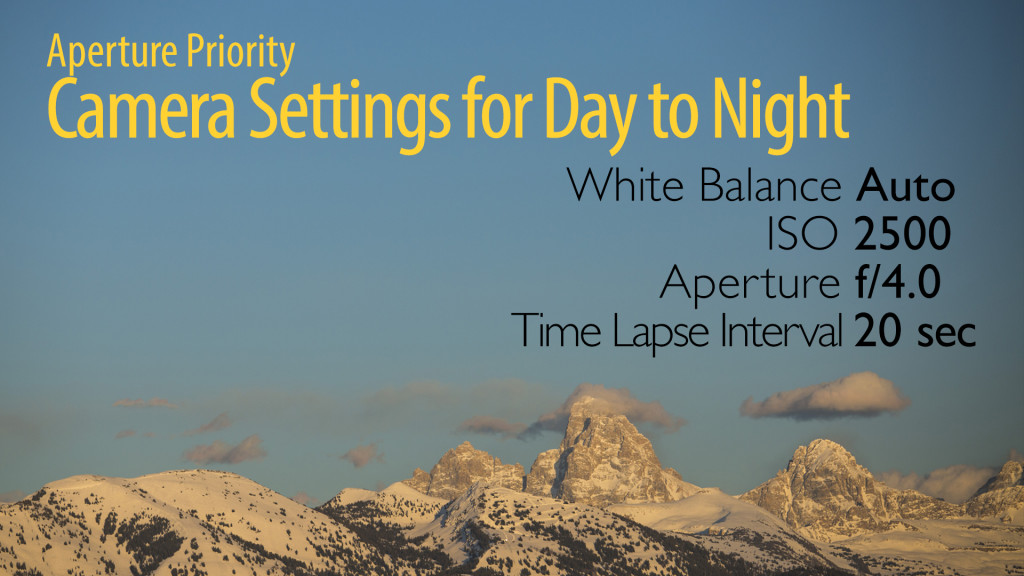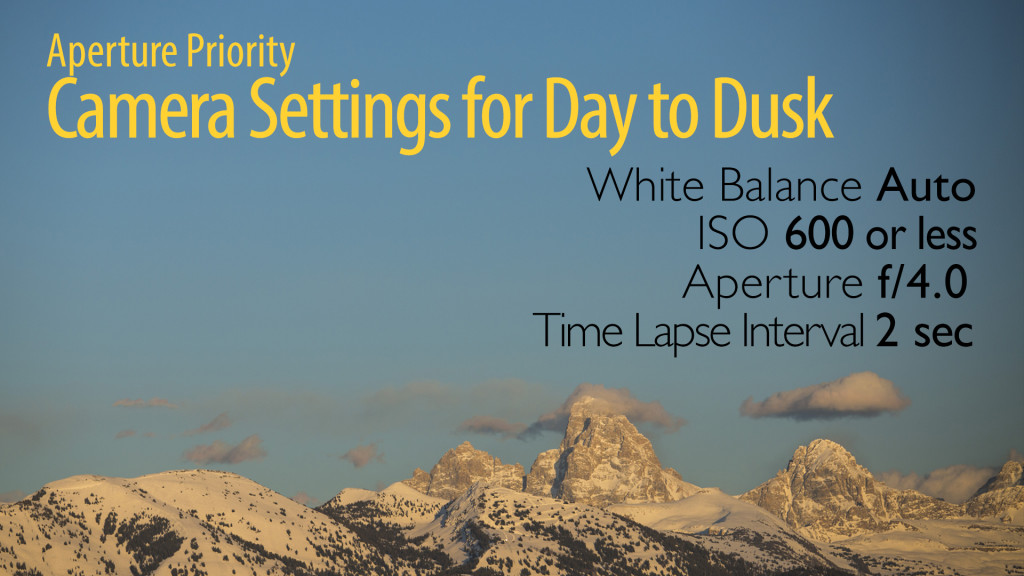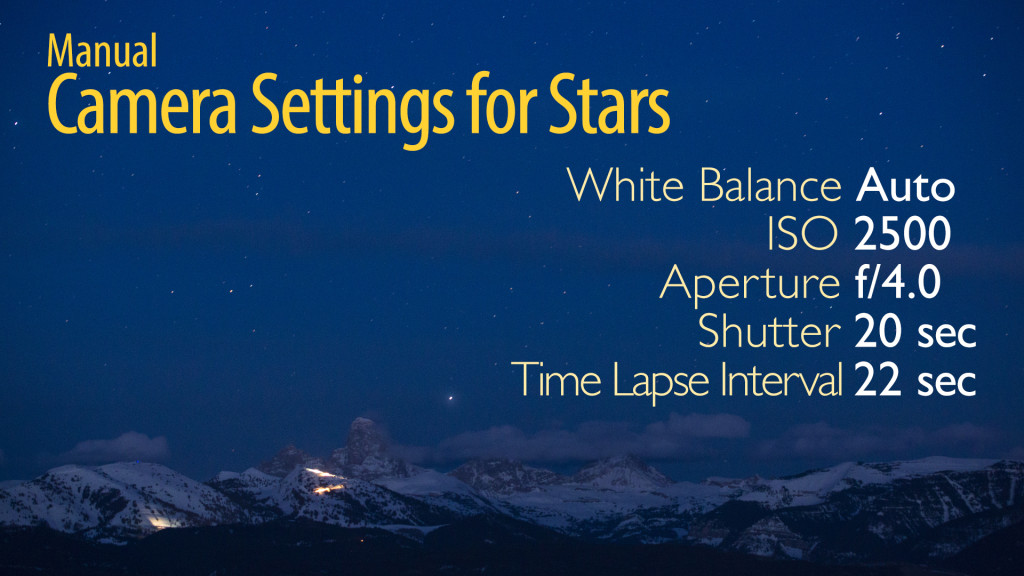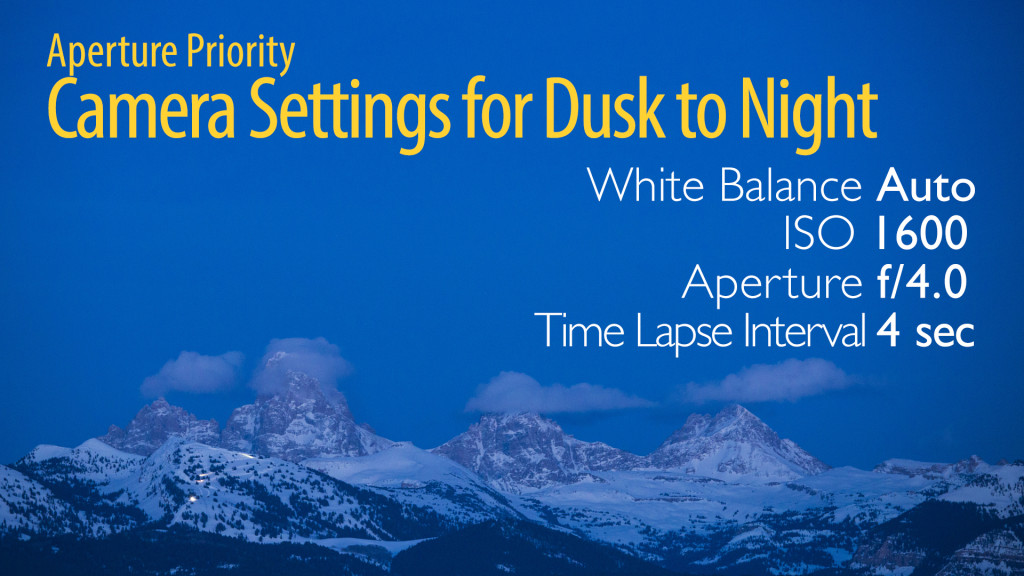Last chance to sign up for my photography workshop! Take 25% with code “workshop25” off if you sign up today! 
Hi, this is Jay P. Morgan. Today on The Slanted Lens we’re on the Idaho side of the Grand Tetons. It was cloudy when we came up here and scouted our location. They looked like they were gonna be a whole lot closer than they actually are. But our goal here today is to show you how to take time-lapse from day into those stars at night using the Genie, and Genie Mini from Sryp. We’re gonna do that by blending three time-lapses together. We’re going to do a time-lapse as the sun goes down. Another as the sky transitions to dusk where the sun’s down but the light is luminous. And then we’re gonna do one with stars, and we’ll blend those three together in post.
So let’s get started and see what we can do.
Hey, I’m back from Idaho. Picked up a bag of potatoes on my way. Who buys potatoes in Idaho anyway? Just about everybody who lives there I guess. It was freezing cold out there trying to do that time-lapse on the Idaho side of the Tetons. I had my son-in-law, Dallin, doing all the BTS. So we were scrambling between the two of us try to make it all happen. Got a little crazy. So let’s break down exactly what happened doing our time-lapse from day to night.
First we set up three cameras to show us how to shoot day to night for time-lapse. We did that so I could show you three different ways you can do this type of time-lapse. To trigger my camera today I’m using my Syrp Genie and my Syrp Genie Mini. I’m also putting my MIOPS in there to do my third camera. The first camera is stationary and it’s going to use aperture priority through the entire exposure from day to night. I’m not going to change or touch anything. I’m going to set the camera to ISO 2500. The problem with this is that when you’re starting in the daytime it can be pretty hard to get a good exposure at F4. But I want to be able to get a shutter speed fast enough to be able to accommodate that, and I can in this situation. So I’ve got 2500 ISO. I’ve got F4 on aperture priority. I’ve got a 20 second interval between exposures. Now I can start in the beginning and it’s going to be shooting at about 3,000th of a second, 4,000th of a second for shutter. But as it goes into night it’s going to get into two seconds and four seconds and six seconds. That’s why I need that 20 second interval. Because it’s got to give me the ability to go into night and not clip the shutter so I can shoot into those long star shots at nighttime. So there’s our first setup. Lock down, turn it on, let it rock and roll, and it’s gonna give us our time-lapse from day to night.  This is not my favorite way to do these. Obviously on all of these we’re gonna have to deflicker them, because we’re using auto white balance and we’re using aperture preferred which means the shutter is trying to find an exposure, and occasionally it’s going to be off. It’s gonna happen all the way through. Another difficulty with this method is because as it gets darker and darker, the meter is fooled by the darkness and it starts to have a problem finding the correct exposure. But this method isn’t terrible. And I use this a lot of times as my backup time-lapse. If I’ve got two or three cameras going I’ll set this one up and get it rolling. It’ll give me a nice day to night. I know I’ve got some consistency there. It’s gonna roll through and give me at least something. So there’s my first one.
This is not my favorite way to do these. Obviously on all of these we’re gonna have to deflicker them, because we’re using auto white balance and we’re using aperture preferred which means the shutter is trying to find an exposure, and occasionally it’s going to be off. It’s gonna happen all the way through. Another difficulty with this method is because as it gets darker and darker, the meter is fooled by the darkness and it starts to have a problem finding the correct exposure. But this method isn’t terrible. And I use this a lot of times as my backup time-lapse. If I’ve got two or three cameras going I’ll set this one up and get it rolling. It’ll give me a nice day to night. I know I’ve got some consistency there. It’s gonna roll through and give me at least something. So there’s my first one.
Camera number two is set up the way I like to shoot time-lapse when you’re going from day to night. I’m gonna combine an aperture priority piece of time-lapse, daytime into dusk, with a manual time-lapse once it’s dark. With aperture priority setting I don’t have to have 2500 ISO. I can back my ISO way back to 600, or 300, even 160 if I want to. I’m aperture priority, F4, with two second intervals. And now I’m just gonna let my shutter take my exposures until it gets longer and longer. As soon as that shutter hits about two seconds, or a second and a half, I’m now going to turn that time-lapse off. I’ve shot it long enough into dusk to be able to combine with the night footage. I’m now gonna switch to my manual nighttime camera settings. Those are: auto white balance, ISO 2500, F4, shutter set at 20 seconds.
And now I’m just gonna let my shutter take my exposures until it gets longer and longer. As soon as that shutter hits about two seconds, or a second and a half, I’m now going to turn that time-lapse off. I’ve shot it long enough into dusk to be able to combine with the night footage. I’m now gonna switch to my manual nighttime camera settings. Those are: auto white balance, ISO 2500, F4, shutter set at 20 seconds. The interval on our Genie Mini is gonna be set to 22 seconds. You can shoot this star section to be as long as you want it to be. 24 frames equals one second. And your Genie Mini will tell you. If you say, “I want 48 seconds,” it’ll tell you how long you’ve got to shoot. That’s one of the nice things it does for you. You’re only getting about three exposures a minute with 22 second intervals, so it takes a long time to get 48 seconds. Actually Dallin and I got a little impatient and were freezing to death. We didn’t shoot them as long as we should have. And you’ll notice that in the samples. But anyway.
The interval on our Genie Mini is gonna be set to 22 seconds. You can shoot this star section to be as long as you want it to be. 24 frames equals one second. And your Genie Mini will tell you. If you say, “I want 48 seconds,” it’ll tell you how long you’ve got to shoot. That’s one of the nice things it does for you. You’re only getting about three exposures a minute with 22 second intervals, so it takes a long time to get 48 seconds. Actually Dallin and I got a little impatient and were freezing to death. We didn’t shoot them as long as we should have. And you’ll notice that in the samples. But anyway.
Camera number three incorporates the way I like to shoot time-lapse, that’s that aperture priority into dark. My manual settings in the dark for doing the stars. But I’m going to add a move with my Syrp Genie and just let it sweep across that horizon. I’ve got a 70-200mm lens on my camera at about 135mm. So I don’t have to have a huge move to be able to have a nice sweep across those Tetons. It’s about eleven degrees. I set it up, I preview it, I like it. I now move it back to the beginning point and I start it on the first aperture priority pass. I’m gonna make three passes. I’m gonna let that Genie pass the first time at aperture priority. That’s gonna take me about thirty minutes, so I’m gonna start about 30 minutes before sunset. It can be as low as one sixty ISO. I’ve got a shutter speed that’s gonna fluctuate because I’m on aperture priority. And I’m on auto white balance. That’s my first pass. Now I’m gonna reset that back to the original position. The sky is starting to get pretty dark. It’s in that dusky time but it’s not super dark yet. I’m gonna go to just a little longer interval. I’m gonna expand that to maybe four seconds. But now the exposures get longer. Still on auto white balance. And I shoot through one more pass. That’s my second pass.
Now I’m gonna reset that back to the original position. The sky is starting to get pretty dark. It’s in that dusky time but it’s not super dark yet. I’m gonna go to just a little longer interval. I’m gonna expand that to maybe four seconds. But now the exposures get longer. Still on auto white balance. And I shoot through one more pass. That’s my second pass.  Now it’s dark and at this point I put it back to the beginning point once again. I go to my manual star settings and I shoot one more pass with the manual star settings.
Now it’s dark and at this point I put it back to the beginning point once again. I go to my manual star settings and I shoot one more pass with the manual star settings.  Let’s talk about the post process. First I’m gonna use my Datacolor Spyder5PRO. I’m gonna calibrate my monitor so I know the images are looking the way I want them to look. After I’ve done that I’m now ready to take my images. So let’s talk about my first camera- the one that I shot all on aperture priority. I’m gonna take all those in to Camera RAW. I’m going to correct the first one and I’m going to sync them all. I’ll then quickly check the last few that are at night and just see if that color holds through. I may make some adjustments to make sure that that color’s gonna hold from beginning to end and look good. And then I’m going to export them all as JPEGS. That we can bring into Premier as an image sequence, put it on a timeline, and there’s our time-lapse.
Let’s talk about the post process. First I’m gonna use my Datacolor Spyder5PRO. I’m gonna calibrate my monitor so I know the images are looking the way I want them to look. After I’ve done that I’m now ready to take my images. So let’s talk about my first camera- the one that I shot all on aperture priority. I’m gonna take all those in to Camera RAW. I’m going to correct the first one and I’m going to sync them all. I’ll then quickly check the last few that are at night and just see if that color holds through. I may make some adjustments to make sure that that color’s gonna hold from beginning to end and look good. And then I’m going to export them all as JPEGS. That we can bring into Premier as an image sequence, put it on a timeline, and there’s our time-lapse.
For number two I’ll do the exact same thing. I bring the first sequence into Camera RAW, I process the images with the color that I like. Then I bring the second sequence in and I process those with the process that I like there. I’m gonna look at that color just to make sure that it’s pretty close. Because the ending of one is gonna bleed into the beginning of the next. I want to make sure that the color looks good together, or at least will cross dissolve together. It can change color a little bit, that’s fine, because we’re doing it to dissolve on the timeline. Bring those two image sequences into Premier, stack one on top of the other and a nice long dissolve between the two. You have your beginning to end.
Camera three is going to use the very same process that camera two did, except we’re going to incorporate our move. What happens is we take each of these moves and create image sequences for each one of them. Now we’re going to stack these in Premier. The trick is that we’ve got to line them up so that there isn’t a ghosting look of the Tetons as one goes to the next. They’ve got to lay right on top of each other so we seamlessly go from the beginning, to the middle, to the end. So here’s our example, blending those three different image sequences. You’ll see at the very end of it though it’s got a bunch of flashing lights in it. It was a truck that pulled up. Some guy in Idaho’s going, “What are you guys doing out here?” Which is a pretty legitimate question at one in the morning on some dude’s farm. He was very nice though. And off he went.
I love doing this and I want to do more of it. I want to get better at this and refine this day to night experience. If you’re doing your own, get out there and shoot them. Put them up on our Facebook group. Let us take a look at them. We want to see your time-lapse in our Facebook group. Join the Facebook group on The Slanted Lens Facebook page. You can share your content, images, time-lapse and the things you’re doing. We take a look as a community and help each other grow there. So I hope you enjoyed this as much as I did.
Keep those cameras rollin’ and keep on clickin’.
-Jay P.